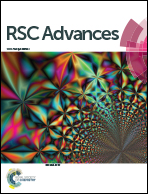Controllable synthesis of ultrathin gold nanomembranes†
Abstract
The growth of Au nanomembranes is realized using an anisotropic hexadecylglyceryl maleate (HGM) hydrogel with a one-dimensional periodic lamellar structure. Compared with other systems, the growth of Au in the HGM hydrogel is slower, such that the formation process of such 2D films can be observed clearly. The produced Au nanomembranes possess atomically smooth surfaces and exhibit excellent optical and electrical properties.


 Please wait while we load your content...
Please wait while we load your content...